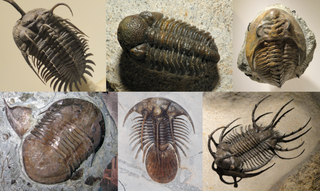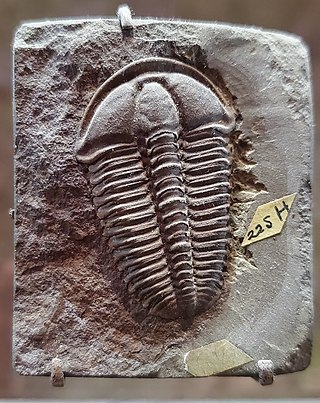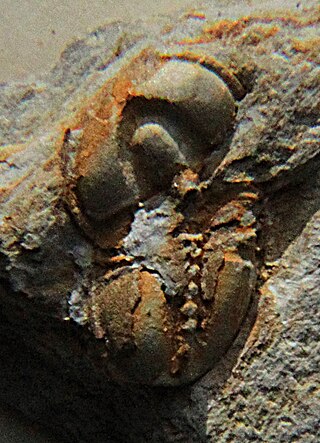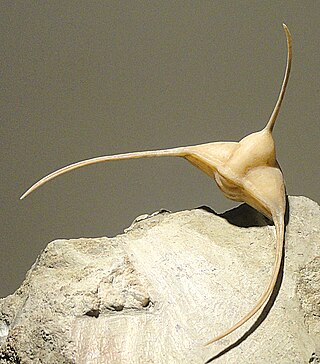
Trilobites are extinct marine arthropods that form the class Trilobita. Trilobites form one of the earliest known groups of arthropods. The first appearance of trilobites in the fossil record defines the base of the Atdabanian stage of the Early Cambrian period and they flourished throughout the lower Paleozoic before slipping into a long decline, when, during the Devonian, all trilobite orders except the Proetida died out. The last trilobites disappeared in the mass extinction at the end of the Permian about 251.9 million years ago. Trilobites were among the most successful of all early animals, existing in oceans for almost 270 million years, with over 22,000 species having been described.

The Phacopina comprise a suborder of the trilobite order Phacopida. Species belonging to the Phacopina lived from the Lower Ordovician (Tremadocian) through the end of the Upper Devonian (Famennian). The one unique feature that distinguishes Phacopina from all other trilobites are the very large, separately set lenses without a common cornea of the compound eye.

Phacopidae is a family of phacopid trilobites that ranges from the Lower Ordovician to the Upper Devonian, with representatives in all paleocontinents.

Pagetia is a genus of small trilobite, assigned to the Eodiscinid family Pagetiidae and which had global distribution during the Middle Cambrian. The genus contains 55 currently recognized species, each with limited spatial and temporal ranges.

Biceratops is an extinct genus of olenelloid redlichiid trilobites, of average size, with the largest specimen 8 centimetres or 3.1 inches long, not including the huge pleural spines of the 3rd segment of the thorax. It lived during the Toyonian stage, in what is today the South-Western United States. Biceratops can easily be distinguished from other members of Biceratopsidae by the absence of genal spines, in combination with effaced features of the raised axial area of the head shield, that is bordering the two horn-like projections that carry the eyes. Biceratops nevadensis is the only known species in this genus.

Conocoryphe is a genus of primarily eyeless trilobites belonging to the family Conocoryphidae. They lived during the Middle Cambrian period, about 505 million years ago. These arthropods lived on the sea bottom (epifaunal) and lived off dead particulate organic matter.

Eodiscina is trilobite suborder. The Eodiscina first developed near the end of the Lower Cambrian period and became extinct at the end of the Middle Cambrian. Species are tiny to small, and have a thorax of two or three segments. Eodiscina includes six families classified under one superfamily, Eodiscoidea.

Trinodus is a very small to small blind trilobite, a well known group of extinct marine arthropods, which lived during the Ordovician, in what are now the Yukon Territories, Virginia, Italy, Czech Republic, Poland, Denmark, Sweden, Svalbard, Ireland, Scotland, Wales, Iran, Kazakhstan and China. It is one of the last of the Agnostida order to survive.

Ogygiocarella Brongniart, 1822, is a genus of asaphid trilobites. It occurred during the Middle Ordovician.

Thoracocare is a minute to very small trilobite, that lived during part of the Middle Cambrian in what are today the states of Idaho, Nevada and Utah. It is the only trilobite known with just two thorax segments outside most members of the Agnostida order. It can be distinguished from Agnostida by the very wide subquadrate glabella, parallel-side or widening forward in the largest specimen, with the full front side touching the border. Two species are known, one, T. idahoensis, only from pygidia.

Cyclopyge is a genus of small to average size trilobites that lived during the Ordovician. Like all members of the family Cyclopigidae, it has very large convex eyes, that cover most of the free cheeks, and in some species touch each other. The eyes almost touch the large glabella. The occipital ring has merged with the rest of the glabella. The glabella does not extend into a frontal thorn. The cephalon lacks genal spines. The 6 thorax segments have short pleurae. The pygidium is rather large, and often rather effaced. These are features that also occur in other Cyclopygidae, and are indications of a pelagic lifestyle.
Emmrichops is a genus of average size trilobite, assigned to the Cyclopygidae family, that lived during the Middle Ordovician (Llanvirn), and have been found in what are today the Czech Republic and in Wales. Like other cyclopygids, it has huge eyes, that occupy almost the entire free cheeks, six thorax segments and a wide tail shield. Like the other cyclopygids, Emmrichops probably lived hunting plankton in the water column. Only one species, E. planicephala, has been described sofar.

Symphysops is a genus of trilobites of average size, belonging to the Cyclopygidae family. It had a cosmopolitan distribution and lived from the Middle to the Upper Ordovician. It has been found in Canada, China, the Czech Republic (Bohemia), Iran, Ireland, Kazakhstan, Poland, Morocco, Spain, Scotland and Wales. The name Symphysops refers to the fused eyes, common to the species of this genus. Some (sub)species of the cyclopygid genera Cyclopyge and Pricyclopyge share this character, but Symphysops uniquely combines the merged eye with a frontal thorn on the head and the "lower eyelid".
Prospectatrix is a genus of trilobites of average size, that lived in the Lower Ordovician and is probably ancestral to the other genera of the Cyclopygidae family. Its eyes are only moderately enlarged and it has six or seven thorax segments.
Sagavia is a genus of trilobites that lived during the Middle and Upper Ordovician in what are now Northwest and Southeast China, North Kazakhstan and Wales. It is a typical cyclopygid that can be distinguished by its large but separate eyes, elongated glabella, five thorax segments and a pygidium with clearly defined axis and border.

Pricyclopyge is a genus of trilobites assigned to the family Cyclopygidae that occurs throughout the Ordovician. Pricyclopyge had an extratropical distribution, and there is evidence that it lived in darker parts of the water column. Pricyclopyge has huge eyes, an inverted pear-shaped glabella, six thorax segments, with on the 3rd two small discs. Pricyclopyge is known from what are today China, the Czech Republic, France, and the United Kingdom.

Raphiophoridae is a family of small to average-sized trilobites that first occurred at the start of the Ordovician and became extinct at the end of the Middle Silurian.

Pliomera is a genus of trilobites that lived during the Middle Ordovician on the paleocontinent Baltica, now Norway, Sweden, Estonia and the Russian Federation, and in Argentina. It can be recognized for its pentagonal glabella widest between the frontal corners, with an inverted V-shaped occipital ring. In front of the occipital furrow that crosses the entire glabella, two pairs of dead-ending furrows create three side lobes left and right. The front of the glabella also has three dead-ending furrows, a very short one on the midline and left and right a longer one, directed inward and slightly backward. The eyes are small and are not connected to the glabella by an eye ridge. The thorax and pygidium are very regularly divided into up to 23 rather narrow segments, without a furrow within each of the pleurae. The pleurae are clearly wider than the axis. The pygidium ends in downward pointing toothlike spines.

The Paradoxidoidea Hawle & Corda 1847, are a superfamily of trilobites, a group of extinct marine arthropods. They occurred during the late Lower Cambrian (Toyonian) and disappeared at the end of the Middle Cambrian.

Telephinidae is a family of pelagic trilobites with large wide-angle eyes, occupying most of the free cheeks, downward directed facial spines and 9-10 thorax segments. The family is known during the entire Ordovician and occurred in deep water around the globe.



















